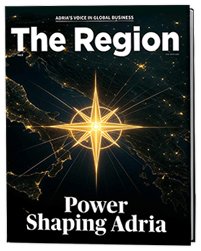Once hunted to the edge of extinction, the wolves of the Adria mountains are finding their way back. Their story is one of instinct, endurance – and an uneasy coexistence with humankind.
As autumn colours deepen across the Dinaric Alps, a long-forgotten rhythm stirs again in the forests. A distant howl rolls through the valleys of Gorski Kotar, across the Slovenian Karst, into the pine-shadowed ranges of Montenegro. It is a sound that once vanished from much of the Adria region — and one that many believed would never return.
The wolf, a symbol of wilderness and fear, has reclaimed its ground. In just two decades, populations have quietly spread along the “green spine” of the Balkans, moving through Slovenia, Croatia, Bosnia and Herzegovina, Montenegro, and Albania. Cross-border corridors now connect once-isolated packs, allowing wolves to travel hundreds of kilometres in search of food, mates, and safety.
Did You Know?
• The Dinaric-Balkan wolf population is one of Europe’s largest, spanning seven countries.
• Wolves can travel up to 70 km in a single night.
• Each pack has a distinct howl pattern — a kind of vocal fingerprint.
Guardians and Ghosts
At dawn, fresh pawprints appear on muddy tracks near Risnjak National Park. Camera traps capture fleeting images: a mother with two cubs, a lone male crossing a frozen stream, eyes glowing in infrared light.
For biologists, these moments are proof that coexistence is working — fragile, but real.


“The wolf is not returning because of us,” says one wildlife researcher in Croatia. “It’s returning despite us — because nature always finds a way.”
Still, the balance is delicate. Wolves prey mainly on wild deer and boar, yet occasional attacks on livestock reignite old fears. In rural villages, farmers and environmentalists still argue across fences, each defending their way of life. In Slovenia, compensation schemes and better fencing have helped reduce conflict. Elsewhere, mistrust lingers — but so does a sense of awe.
Conservation Highlights
• Slovenia and Croatia: joint monitoring since 2009
• Bosnia: first national wolf census in progress
• Montenegro & Albania: new protected corridors under EU LIFE programme
The Last Howl
Night falls over the forests of Lika. The air is sharp with frost, the moon bright. Somewhere beyond the treeline, a pack begins to call — first one, then several, a haunting chorus carried by the wind.
For centuries, people told stories of wolves as monsters. Now, perhaps, the greater story is ours: whether we can learn to live alongside what we once sought to destroy.
Their presence reminds us that wilderness still exists, stubborn and beautiful, even in a region that has rebuilt itself from conflict and change. The return of the wolves is not just about nature’s resilience. It’s about ours.
Across Borders, Beyond Fear
Unlike humans, wolves ignore the lines on a map. Packs travel freely between countries, reminding us that the Adria’s wilderness is one shared ecosystem. Slovenia and Croatia cooperate under the Dinaric-Balkan Wolf Population Initiative, sharing genetic data and migration tracking.
Montenegro and Albania are now joining conservation networks too, as new ecotourism projects turn the wolf’s comeback into an economic opportunity.
In Prokletije National Park, rangers guide visitors on “wolf trails,” teaching them to identify tracks and respect the animal’s role in maintaining balance. “If the wolf is here,” one guide explains, “it means the forest is healthy.”
Across the region, attitudes are shifting — from fear to fascination. The wolf is no longer just a threat; it has become a mirror of our relationship with the wild.

